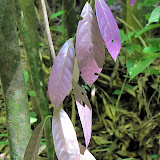Today we joined Stephan Schneitzer, 2 of his post doctoral researchers, and two undergrad students; Liz and Dathan, in the tropical forest to do some real rainforest science! Stefan Schneitzer is currently researching the maintenance of species diversity.
One model he uses to study the maintenance of biodiversity is lianas. A liana is a woody vine so this encompasses many different species of vines. These lianas sometimes take over the trees in which they climb. In many instances their growth rises to the forest canopy and
encompasses many different species of vines. These lianas sometimes take over the trees in which they climb. In many instances their growth rises to the forest canopy and
As we walked to the central plateu where we recorded our observations we saw many interesting things along the way!
One model he uses to study the maintenance of biodiversity is lianas. A liana is a woody vine so this
 encompasses many different species of vines. These lianas sometimes take over the trees in which they climb. In many instances their growth rises to the forest canopy and
encompasses many different species of vines. These lianas sometimes take over the trees in which they climb. In many instances their growth rises to the forest canopy andsometimes dominates the tree canopy. Today we recorded on a scale 0-4 how much of a particular tree's canopy the liana (if present) was taking up. 0; no liana coverage, 1;0-25% liana coverage, 2;25-50% liana coverage, 3; 50-75
% liana coverage; 4; 75%-100%. After recording this for 4 hours we headed back and compiled our data to check
for reliability and consistency between observers (us). Surprisingly, our ratings were very similiar in all instances.
As we walked to the central plateu where we recorded our observations we saw many interesting things along the way!
Dana and Sarah standing in front of a huge Ceiba tree. It is one of the largest trees in the tropical forest.
The picture of the tree with many roots above ground is the "walking palm."

There are theories as to why the roots grow like this. One is that its root structure is an adaptation that allows it to "walk" a little to maximize exposure to sunlight. Another is that this provides opportunity for seedlings to grow around fallen trees and limbs.
The picture of the small fearless monkey staring down at us is a Howler monkey. These monkeys stay in large groups in the canopy and make spooky howling noises that wake us every morning.

Click below to see more photos of our hike - including an ameiva lizard...
 |
| 50 ha plot |
Loving the howlers! Best alarm clock every morning.
ReplyDeleteHi scientists,
ReplyDeleteThe liana vines seem like they are both good and bad at the same time. The reason I think that it's a bad thing is because it takes water from the trees. The good thing is that it allows the animals to travel from tree to tree. The howler monkeys sound really freaky, and if they woke me up in the morning, I would be like, "WHAT THE HECK IS THAT?" But then I would calm down. Good picture taking Ms Sarah and Ms Thome! One question: what other animal sounds have you heard?
Adios,
Alanna the 4th grader
Hi Ms Sarah and Ms Thome,
ReplyDeleteI have a question for Stephan. Besides studying biology in college, what else did you have to do to become a scientist?
Thank you for making the interesting video,
Jonah
Hola,
ReplyDeleteI think that the howler monkeys sound like wolves howling, and they are very scary. The Walking Palm is very cool, because it can move a little bit and it gives shelter to plants and animals. The roots look like wood from another tree.
Sincerely,
Adele the 2nd grader
Dear scientists,
ReplyDeleteDo you think the Walking Palm is cool? I think it is awesome! Could you post more pictures of the liana vines? Tell us your answers!
Sincerely to be a scientist of animals someday,
Alanna the 4th grader
We'll work more on pictures of lianas - but if you look in just about every picture of the forest, you will see the - they're everywhere!
ReplyDeleteOther sounds of the forest: cicadas, bats, howler monkeys (of course) leaves falling, turkey vulture, birds, túngara frogs (video to come), spider monkeys playing and throwing things - a swish/crashing sound. The forest is never quiet!
S
JONAH ~ a response to your question to Stefan:
ReplyDeleteInteresting question. There are many different characteristics of a scientist. However, what most scientists have in common is that they are interested in understanding how things work. This interest is what drives them to study certain scientific questions. For example, the people in my group and I are interested in what mechanisms maintain diversity and how tropical forests operate. That is why we ask the questions that we do.
If you have this type of personality, what you have to do to become a scientist is simple:
1. Study science in college
2. Get good grades
3. Participate in research when possible as a student
Then you are a junior scientist. If you want to further develop your scientific ability, the following course may be for you:
4. After college enroll in a Ph.D. program, which means another 5-6 years of school where you really learn to become a scientist and to publish scientific papers
5. After you have you Ph.D. you find a post-doctoral research position with a research group at a university or a research center
6. Publish more scientific papers
7. Get a job as a scientist/researcher/professor
That's all there is to it. I hope that answered your question.
Best wishes,
Stefan